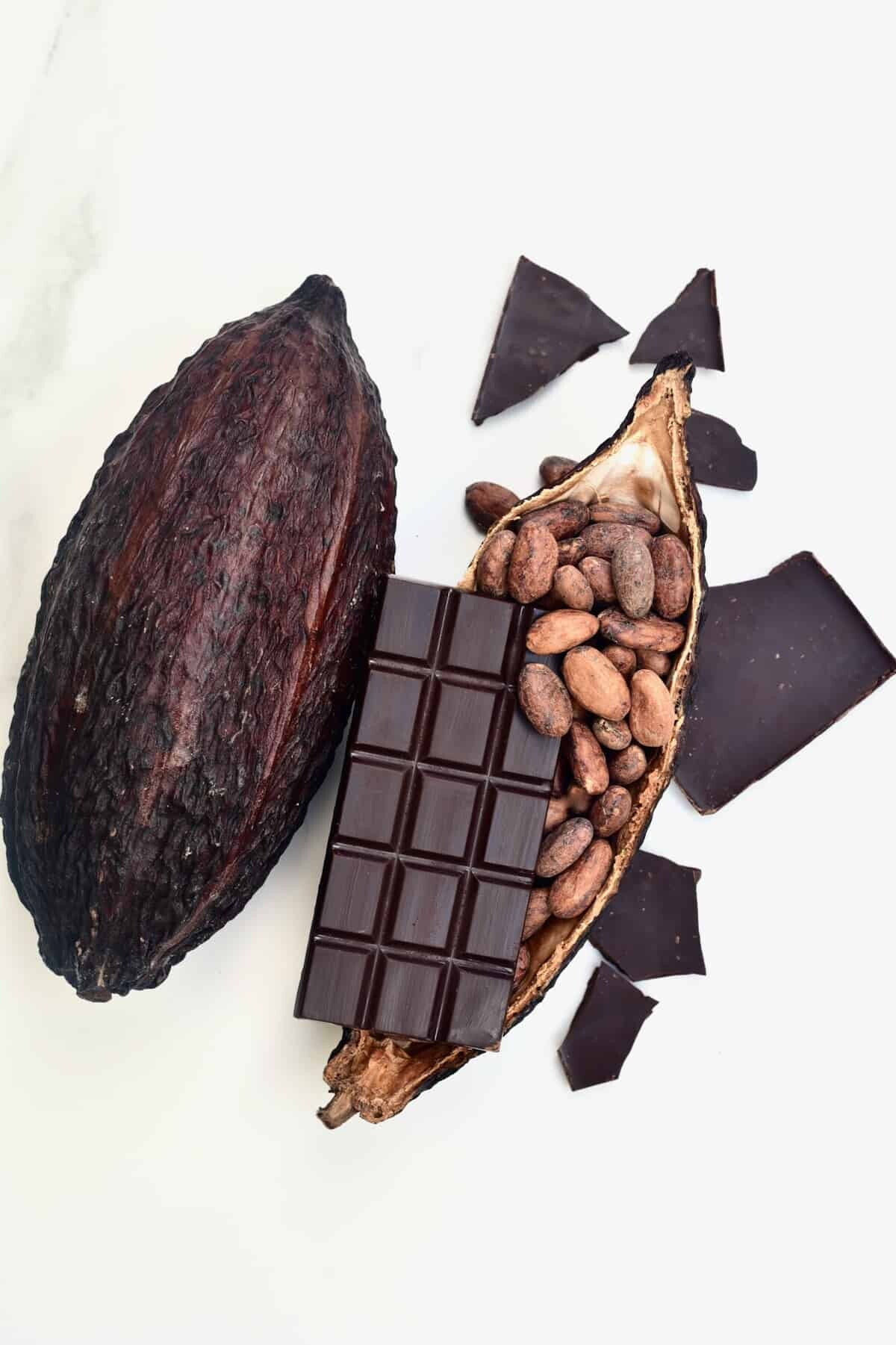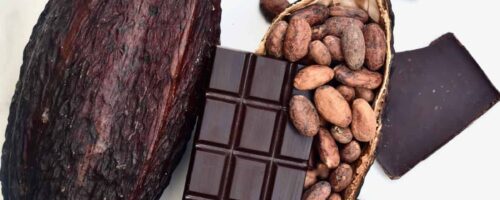
Ghana
How is it produced?
Cocoa beans grow inside a pod. To harvest and refine the cocoa pods into cocoa beans it involves slicing the pod open to remove the beans which are covered in a milky white liquid, the beans are then piled together to ferment, then are laid out in the sun to dry (Cole, 2018). Occasionally small farmers may sell the wet cocoa beans to a local processor who performs this work. Once the beans have dried, they are sold on the open market at a fluctuating price determined by commodities traders. The cocoa beans are now handled by small chocolate makers or large corporations to be turned in to chocolate (Cole, 2018).
Describe the supply chain to the store shelf in Canada:
Cocoa starts in the farms of tropical nations, travels through ports, shipping containers and processing plants, sold by commodity traders to international trading companies then is shipped to port cities (Gross, 2015). Farmers want to sell their crop at a premium, chocolate companies want to get a good deal on their supply, and commodity traders don’t care which side wins, as long as prices fluctuate. (Gross, 2015). “The trading of chocolate takes place on two exchanges: New York Mercantile Exchange (NYMEX) and the Intercontinental Exchange (ICE) in London. The prices on the ICE function as a benchmark for global price creation” (Agiboo, 2022). The major players in the chain of cocoa are farmers, licensed buying companies (LBCs) and Cocobod (Ghana’s Cocoa Board). Cocobod is government-controlled and regulated the price of cocoa for producers and buyers (Africa Corporate Data, n.d.). Farmers sell their cocoa to the LBCs, who then perform quality checks on the beans. There are 46 LBCs in the market, the largest LBC is public and holds 31% of the market, the two largest private buyers hold a combined market share of 25% (Africa Corporate Data, n.d.). Over 80% of beans purchased are shipped abroad in raw form, value is added in other markets, the local processing is limited to the production of semi-finished goods which are then exported or consumed locally. The processing segment is dominated by three multinationals (Cargill, Barry Callebaut and Olam) and have a combined market share of 71% (Africa Corporate Data, n.d.). The product is then sold to the chocolate company, retailers, and then to consumer. Some factors that can have an effect on the global supply chain are environmental conditions and political unrest. Weather, as with all agricultural commodities is always a factor, because production requires very specific weather conditions, such as temperature and rainfall. Global warming could have major consequences for cocoa farmers (Agiboo, 2022).
What is the power balance between the producer and seller?
The production of cocoa and chocolate is linked to an unfair balance of power between producer and seller in its supply chain. Many of the world’s cocoa producers live in poverty because, as most of the industries that are ruled by capitalism, large global brands that manufacture chocolate do not pay their vast profits down the supply chain (Cole, 2018). In 2015, Green America reported that 44% of all chocolate profits “lie in sales of the finished product,” 35% is captured by manufacturers, and 21% is left for everyone else involved in the production and processing of cocoa (Cole, 2018). Farmers, who arguably are the most important part of the supply chain, receive only 7% of global profits (Cole, 2018). Although the global economy is largely at fault for the injustices within the cocoa and chocolate industry, free market forces could be utilised as a solution. For instance, if there was a demand for more equitable and reciprocal trading agreements this would assure workers a fair labour wage, and favourable conditions for cocoa farmers would lead to a more ethical and sustainable global supply chain. This would force companies to be accountable for the manufacturing of their products if chocolate and the cocoa sourced for it is sustainable and ethical. However, there is likely to be resistance to move towards a more sustainable chocolate industry and global economy. Corporations that sustain themselves through injustice will need to adjust their ways of operating. For example, the cocoa industry appears to be dependent on child labor and enslavement, which is common on the farms in Africa. Large chocolate companies, such as Mars and Nestle have failed to take accountability for the unfair working conditions and child labour in their chocolate production (Bjork, 2022). With efforts to eliminate child labour and establish fair wages, production costs for cocoa will increase, which will consequently influence the eventual price of cocoa (Agiboo, 2022).
Can you recommend changes to the system to improve the balance?
To address the problems of economic inequality and exploitation, there are alternatives for consumers. Fair trade and direct trade chocolate are ethical, traceable ways of sourcing raw materials, although fair trade does not guarantee that cocoa is free from child labour or guarantee living standards for farmers. Direct trade chocolate makers choose farms of which they want to work with and cut out the middleman, thus allowing them to also witness firsthand the working conditions of those on that farm (De Shon, 2022). Despite the difficulties that come from the production of cocoa for the chocolate industry, we as consumers have the ability to increase the supply and demand of sustainable products.
References/Resources:
Image retrieved 23, June 2023 from https://www.alphafoodie.com/how-to-make-chocolate-bean-to-bar/
Africa Corporate Data | Investment in Africa | Africa Companies. (n.d.). Africa Corporate Data | Investment in Africa | Africa CompaniesShort. https://www.asokoinsight.com/content/market-insights/ghana-cocoa-value-chain
Björk, L. (2022). Bitter Sweet: The Chocolate Industry’s Testimony to Global Injustice. Utblick. https://www.utblick.org/2022/01/23/bitter-sweet-the-chocolate-industrys-testimony-to-global-injustice/
Cartier, C. P. (2021). Nestle v. doe and the humanitarian slavery crisis in the cocoa industry. Journal of International Business and Law, 21(2), 174-191.
Cole, N. L., PhD. (2018). Where Does Chocolate Come From? We’ve Got the Answers. ThoughtCo. https://www.thoughtco.com/all-about-the-global-chocolate-industry-3026238
De Shon, P. (2022). What Is Fair Trade & Direct Trade Chocolate? Bar & Cocoa. https://barandcocoa.com/pages/fair-trade-direct-trade-chocolate
Everything you need to know about the commodity Cocoa. (2022). Agiboo. https://www.agiboo.com/cocoa/
Gross, D. A. (2015). The Economics of Chocolate. Smithsonian Magazine. https://www.smithsonianmag.com/arts-culture/economics-chocolate-180954224/
Van Vliet, J. A., Slingerland, M., Waarts, Y., & Giller, K. E. (2021). A Living Income for Cocoa Producers in Côte d’Ivoire and Ghana? Frontiers in Sustainable Food Systems, 5. https://doi.org/10.3389/fsufs.2021.732831
Where Do Cocoa Beans Grow? | Lake Champlain Chocolates. (n.d.). https://www.lakechamplainchocolates.com/where-do-cocoa-beans-grow/

